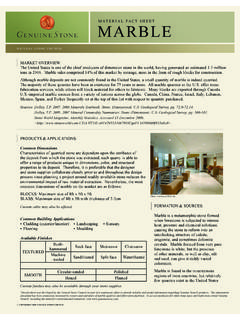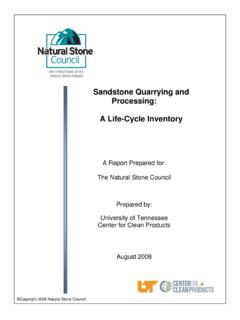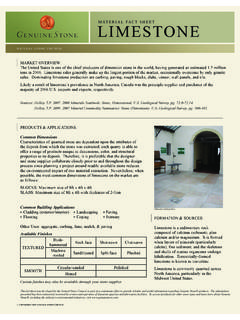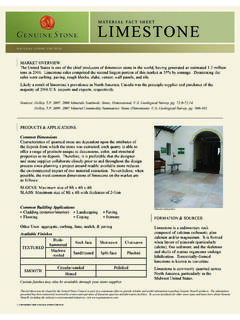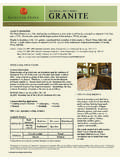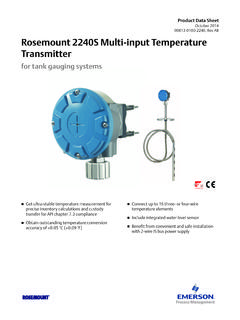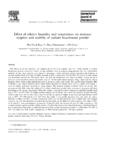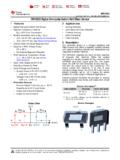Transcription of CASE STUDY - The United Voice of the Natural …
1 C A S E S T U DY: N a tu r a l S to n e S o l a r Ref l ecta n ce I n d ex a n d th e U r b a n H ea t I s l a n d E f f e p a r ed B y T h e U n iver s i ty o f Ten n es s ee C en ter f o r C l ea n Pr o d u ct U L 1 7 2 0 0 9 C O P Y R I G H T 2 0 0 8 N AT U R A L S T O N E C O U N C I LAn IntroductIon to HeAt IslAndsA significant impact of the built environment is the generation of a heat island, an area of increased ambient air temperature due to absorption and release of the sun s energy by buildings and other manmade structures. Heat islands are most common in urban areas where surfaces are comprised of synthetic materials. In particular, roofing and pavement absorb heat from the sun, especially when their capability to reflect solar radiation is poor.
2 When the absorbed heat is returned to the air (through convection), the resultant raise in temperature can be quite burdensome on air quality, Natural resources, and ecosystems. For instance, one of the main ingredients of smog is heata. Temperature raises fuel smog formation, creating visual impairment and health hazards. Additionally, a constituent of smog is ground-level ozone, which can cause short-term or chronic respiratory injury. Heat islands are particularly of concern when the ambient temperature is high, clouds and wind are absent, and the sun sits at a steep angle to the earth s surface. The sun is most powerful when at its highest point in the sky because incoming radiation strikes (horizontal) surfaces at nearly 90 angles, essentially allowing very little reflection of the heat. Cloud cover can mitigate this intensity, while ambient air temperature only exacerbates heat islands.
3 In effect, both the season and geographic location affect the generation of urban heat amount of heat absorbed by a building determines the quantity of energy expended by the building s cooling system. As such, increased absorption results in greater consumption of energy, which requires further energy production and the generation of additional pollutants. Even when a building is cooled by precipitation, the heat transferred to the water can strain ecosystems of the receiving waterbody. Therefore, designing to mitigate the occurrence of heat islands is imperative in reducing the overall environmental footprint of a oF solAr reFlectAnce Index (srI)The metric associated with the heat island concept is known as Solar Reflectance Index (SRI). Defined by the Cool Roof Rating Council (CRRC)b, SRI is calculated as the ratio of the reflected flux to the incident flux.
4 1 Essentially, it is the ability of a material to reject solar energy. As such, a material s contribution to a heat island decreases with increasing SRI. Relatively high SRI products are referred to as cool materials, such as cool roofs and cool islands (and SRI) are often thought to correlate with the color of a material, since lighter colors reflect more of the visual spectrum than darker colors. While color may provide a relative estimate of a material s ability to generate a heat island, it is not the only determining factor. Two pieces of information are needed to compute the SRI of a material: solar reflectance and thermal reflectance, or albedo, is the ability of a material to reflect rather than absorb energy emitted from the sun. This parameter is measured on a scale from zero to one with values approaching one as reflectance increases.
5 As the shade of a material darkens, its reflectance typically is reduced. However, since color is not always an accurate indicator of solar reflectance, testing is recommended to correctly characterize the emittance or emissivity is defined as the ability of a body to release heat. Similar to solar reflectance, thermal emittance is measured on a scale from zero to one, with a higher value implying a larger release of absorbed energy. However, materials exhibiting low emissivity can still remain relatively cool in sunlight if their solar reflectance is exceptionally When solar reflectance and thermal emittance are combined, the SRI can be determined. ASTM provides a standard calculating procedure under ASTM E1980 (Roofing Standards). The computation generates a number from 0-100%, with 100% being the most reflective and thus least capable of generating a heat Photochemical smog is a product of the reaction between heat, oxygen, nitrous oxide, and volatile organic compounds, of which the latter two in the United States source predominantly from coal-fired power plants and internal combustion engines ( , automobiles)
6 , The CRRC is an independent, non-profit organization that has established a rating system for radiative properties of roofing materials and maintains a directory of products SRI and thermal emissivity that have been validated by CRRC-accredited STUDY Natural S TONE S OLAR R EfLECTANCE I NDEx AND THE URBAN HEAT I SLAND EffECTP repared By The University of Tennessee Center for Clean oF Natural stoneNatural stone has the potential to be a cool roofing or paving material, an attribute with a number of marketable advantages. In particular, stone can support reduced energy consumption, decreased utility costs, an improved environmental footprint, and the potential to earn LEED credits. The Natural Stone Council (NSC) advises that any claims of stone being a high SRI product must be substantiated through professional material stone used as a building or landscaping material can decrease the urban heat island effect if the solar reflectance index of the surface is sufficient.
7 Roofing tiles, large decorative pieces, and other stone on a building s envelope may inhibit energy absorption. Paving or landscaping with stone may also result in similar advantages. Again, material testing should be performed to ascertain this alternative products, the SRI of only a small quantity of Natural stone has been measured; the examples provided at the end of this document confirm values in the area of The University of California s Lawrence Berkeley National Laboratory (LBNL), the leading research group on cool roofing materials, publishes a list of common building materials SRI values. Table 1 displays some of those 1. Radiative properties, temperature rise, and SRI of various building materials as reported in the LBNL Cool Roofing Materials Database.*Maximum roof temperature rise.
8 **Average of three light-colored, honed limestones reported from Valder s Stone & Marble, Inc., who used an accredited CRRC testing facility to evaluate their stone. Temperature Rise is predicted by UT based on the known linear relationship between this variable and SRI. This data is not reported by the oF HIgH srI stone ProductsProducts with a high SRI are particularly advantageous in regions that exhibit only short periods of cold weather. In predominantly cold areas, these materials have been shown to contribute to higher heating demands due to an inability to absorb energy from the sun3. Energy savings, however, are still generated during the summer months. In any case , cool materials become increasingly beneficial as the ambient temperature CreditsThe Green Building Council s (USGBC) Leadership in Energy and Environmental Design (LEED) certification program is the preeminent green building rating system in the United States.
9 The program awards credits to construction projects for implementing environmentally-conscious practices during the planning, design, construction, and operation phases of a building s lifetime. Employing high SRI products is one way of earning a few of these STUDY Natural S TONE S OLAR R EfLECTANCE I NDEx AND THE URBAN HEAT I SLAND EffECTP repared By The University of Tennessee Center for Clean reflectanceemissivitytemperature rise*srIClay tile, redConcrete tile, redConcrete tile, whiteAsphalt shingles, whiteLimestone pavers** ~303617902162 LEED as well as LEED v3 provide the opportunity to earn two points for the use of high SRI materials through Sustainable Sites Credits (non-roof) and (roof). These credits can be achieved in a new building or renovation by installing or replacing a roof or non-roof ( , courtyards, parking lots, roads, sidewalks) with a material having sufficient SRI.
10 Credit requires at least 50% of the project s hardscaped area to be constructed of a material with a minimum SRI value of 29. Credit requires at least 75% of the roofing material to have a minimum SRI of 78 for low-sloped roofs and minimum 29 for steep-sloped roofs. Alternatively, if a low SRI material is used, a credit can be earned if the weighted average roofing SRI is at least 75. Additional points may be earned for exceeding these criteria under the Innovation in Design (ID) category; contact the USGBC for more ProgramsUtility companies are now offering rebate incentives for employing cool roofs in. Depending on the program, rebates are available for residential, commercial, and industrial projects. Some states where these programs exist at the time of this publication include the following: California New York Colorado North Carolina Florida South Carolina Idaho Texas New JerseyContact your local utility company to inquire about potential cool roof rebates in your area, or view the list of rebate programs on the CRRC s website at # SavingsHigh SRI roofs can offer direct energy savings typically between 10-30% for average daily summertime loads as well as peak summertime ,5,6 For instance, a STUDY by the LBNL on three northern California commercial buildings reported that a decrease in solar absorption from to reduced the temperature of the roof surfaces on hot afternoons by 77 F (25 C).
